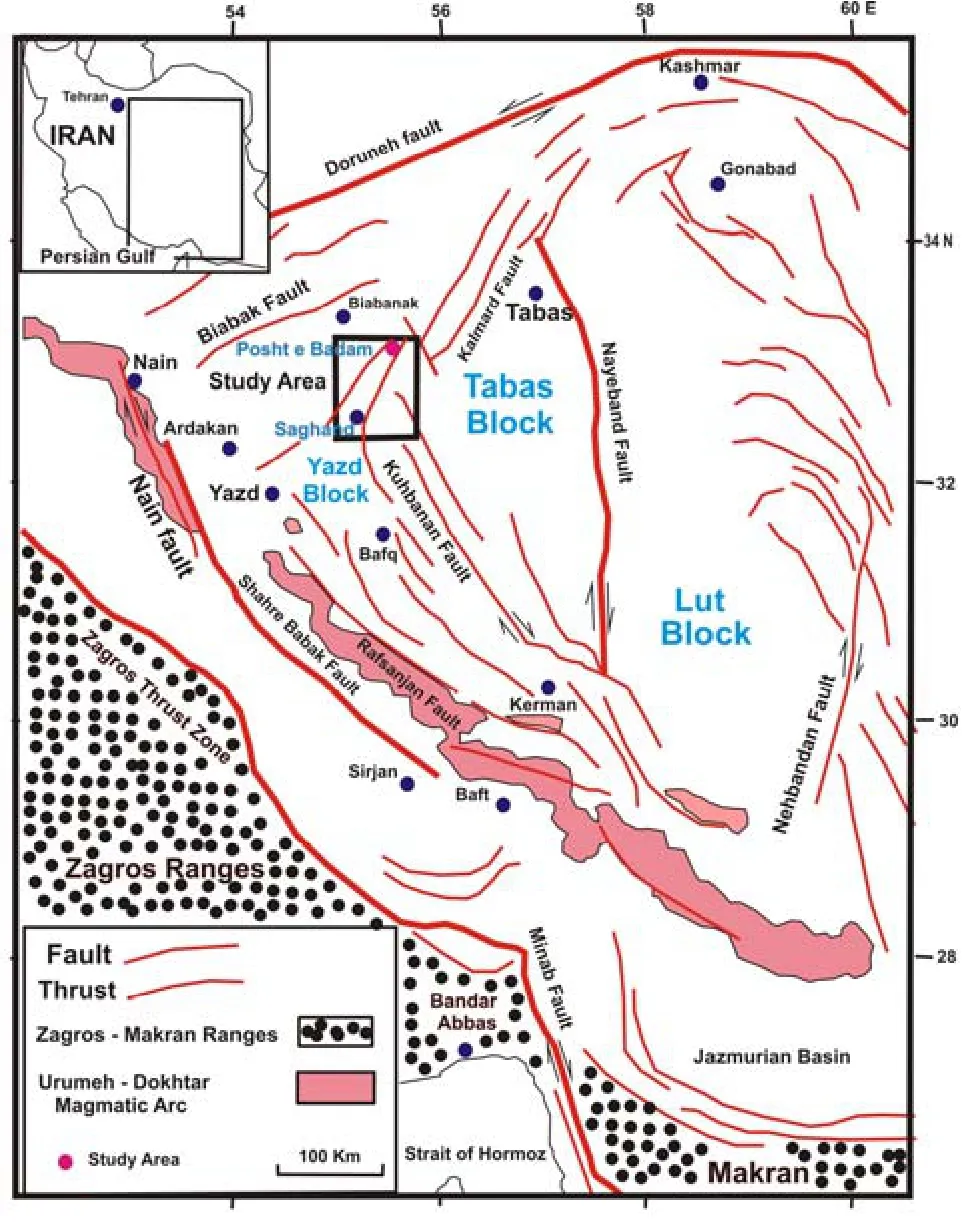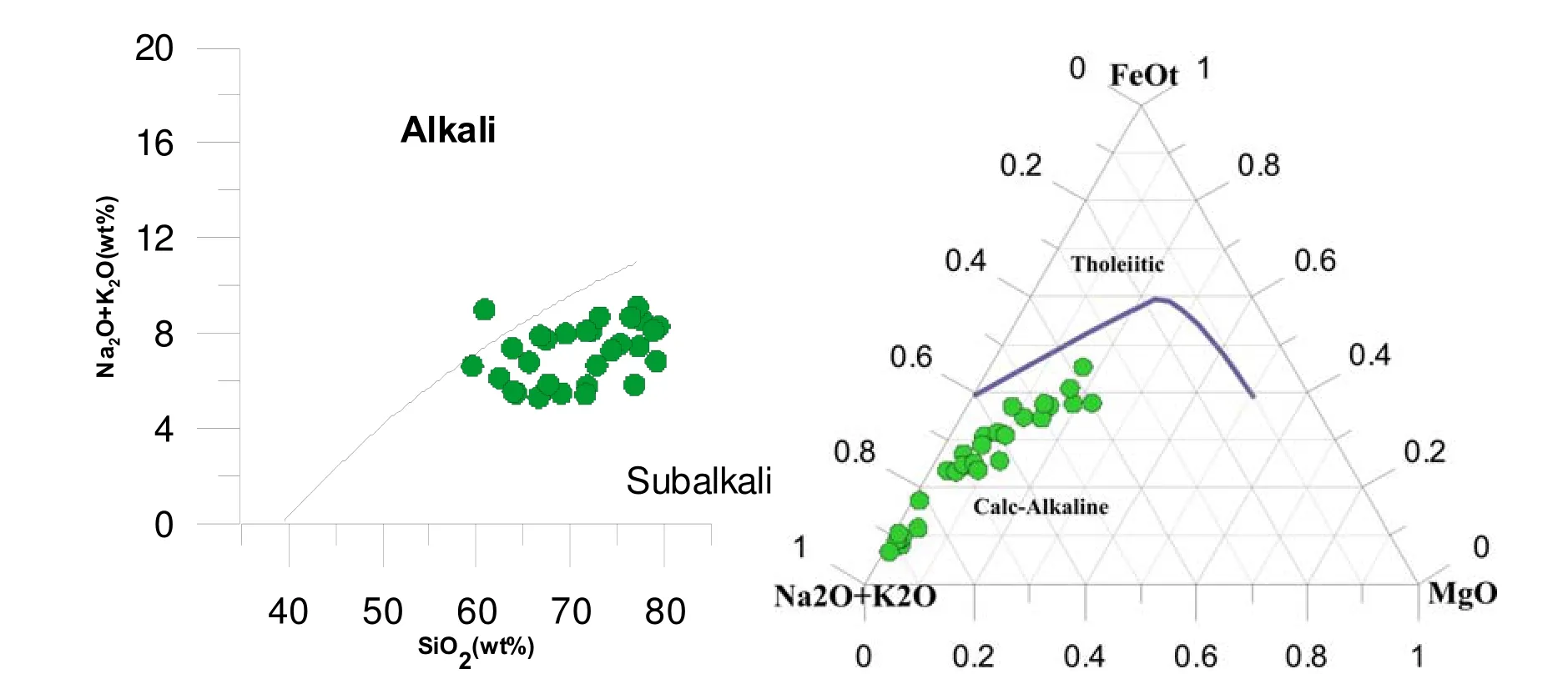伊朗中部原特提斯殘余的評(píng)價(jià)及構(gòu)造環(huán)境:據(jù)地球化學(xué)研究
伊朗中部原特提斯殘余的評(píng)價(jià)及構(gòu)造環(huán)境:據(jù)地球化學(xué)研究
E-mail: m_poshtkoohi@yahoo.com.

Fig. 1 Simplified structural map of central Iran and constituent crustal blocks (after Jackson and McKenzie,1984; Alavi, 1991; Ramezani and Tucker, 2003)
Tectonic evidences from Precambrian geology of this area suggest that orogenic movements comparable with that of Katangan in Gondwana and Baikalian in Eurasian have occurred. Geochemical data of outcropped Precambrian rocks (Fig. 1) suggest that these orogenic movements have occurred in late Proterozoic and/or between the Riphean and Vendian eras. Orogenic changes related to this epoch are widely observed in the Precambrian rocks that can be divided into two main groups. The first group is metamorphic and deformed rocks that belong to Precambrian basement and located below the Katangan unconformity.The second group is predominantly continental rim sequences that aggregated after Katangan and can be categorised as late Precambrian rocks.
The outcrops of basement complexes of Central Iran and Saghand region along the Chapedony and Posht-e-Badam faults show structural vestiges of Precambrian deformational, depositional, erosional,metamorphic and magmatic events. The basement complexes were metamorphosed, intruded by granitoid magmas, folded and faulted during the Late Precambrian by the Pan-African Orogeny. Central Iran and Saghand region complexes consist of gneisses, amphibolites, pelitic schists, meta-ultramaf i c and calc-silicate rocks. The prevailing metamorphism from low grade to high grade is pre-Pan African Orogeny(i.e. from 2400 to 570 Ma). The presence of greenstone belts, a paleo-suture zone and ophiolitic rocks around the high-grade metamorphic rocks of the Chapedony formation provide evidence that cratonization of Iranian basement occurred during the Paleo-and Mesoproterozoic. The Saghand region meta-ultramaf i c rocks can be divided into three types based on dominant mineral assemblage and degrees of serpentinization: metaperidotites, talc–serpentinite rocks and serpentinites. The peridotite protoliths were mainly harzburgites and dunites.
Geochemical analysis suggested that the protoliths of the Saghand region gneisses were slightly peraluminous with calcalkaline aff i nity. In AFM diagram of Rickwood (1989) and TAS diagrams of Irvine and Baragar (1971), all samples show a subalkaline composition and are plotted on the calc-alkaline fi eld (Fig.2). Harker variation plots for major and trace elements(Fig. 3), exhibit a near linear trend for most major elements. In all rocks, MgO, CaO, Fe2O3,Al2O3, TiO2show negative correlations with silica, whereas P2O5is positively correlated and without any variation with respect to Na2O and K2O. The trace elements such as Ba and Rb show more scatter than the major elements.Sr shows a negetive linear trend with increasing SiO2contents. These chemical variations indicate the importance of fractional crystallisation in magmatic evolution of these rocks. Most of samples plot in Zr vs.SiO2binary diagram after Whalen et al. (1987) show I-type characteristics (Fig. 3j).

Fig. 2 Total alkalis versus silica; AFM triangular diagram (after Irvine and Baragar, 1971)
The terminal Neoproterozoic orogeny in Central Iran was related to a broad scale magmatic arc that developed along the Proto-Tethyan margin of the Gondwana supercontinent. All geochemical characteristics and presence of paleosuture zone and remnants of ophiolitic rocks (i.e. serpentines, meta-maf i c and meta-ultramaf i c rocks) around the high grade metamorphic rocks suggest that a continental margin magmatic arc (Andean-type) formed the Saghand Precambrian basement.
The basement complexes are extensively overprinted by the Pan-African Orogeny and younger igneous events. Early Cambrian Orogenesis in the Posht-e-Badam Complex region of Central Iran marks one of the fundamental lithospheric boundaries within Gondwana which belonged to a greater Late Neoproterozoic –Early Paleozoic orogenic system that was active along the Proto-Tethyan margin of the Gondwana supercontinent extending from Arabian margin to the Himalayan margin of the Indian subcontinent.

Fig.3 Variation diagrams of major element oxides and trace elements versus silica of the Saghand region Complexes gneiss. (j) Most of the samples in Zr vs. SiO2 binary diagram showing I-type characteristics (Whalen et al., 1987)
Conclusions
The oldest metamorphic rocks exposed in the Saghand region represent the Neoproterozoic–Early Cambrian magmatic arc complex. This complex belonged to a greater Late Neoproterozoic– Early Paleozoic orogenic system that was active along the Proto-Tethyan margin of the Gondwana supercontinent,extending at least from the Arabian margin to the Himalayan margin of the Indian subcontinent.
Major and trace elements geochemistry suggests that the protoliths of the gneisses in the Saghand region were deposited at an active continental margin setting.
All geochemical characteristics and presence of paleosuture zone and remnants of ophiolitic rocks(i.e. serpentines, meta-maf i c and meta-ultramaf i c rocks)around the high grade metamorphic rocks suggest that a continental margin magmatic arc (Andean-type)formed the Saghand Precambrian basement.
The strips of ultramaf i c rock in the Saghand region can be attributed to lithospheric remnants of the Proto-Tethyan Ocean.
IRVINE T N, BARAGAR W R A. 1971. Guide to the chemical classif i cation of the common volcanics. Canadian Journal of Earth Sciences, 8: 523-545.
RAMEZANI J, TUCKER R D. 2003. The Saghand region, central Iran: U–Pb geochronology, petrogenesis and implications for Gondwana tectonics. American Journal of Science, 303:622-665.
RICKWOOD P C. 1989. Boundary lines within petrologic diagrams which use oxides of major and minor elements. Lithos, 22:247-264.
WHALEN J B, CURRIE K L, CHAPPELL B W. 1987. A-type granites: geochemical characteristics, discrimination and petrogenesis. Contributions to Mineralogy and Petrology 95,407-419.
Evaluation of Tectonic Setting of the Proto-tethyan Remnants in Central Iran: A Geochemical Study
Monireh POSHTKOOHI
Geological Survey of Iran
The Iranian plateau comprises several continental blocks, which are clearly bounded by major faults. The sedimentary, stratigraphic, magmatic and metamorphic features of these blocks vary from one to the other. The continental crust of subject area in Central Iran was investigated in the past by several authors. It was concluded that this zone was metamorphosed, intruded by granites and faulted during late Precambrian Pan-African Orogeny(Ramezani and Tucker, 2003).
Gneisses; ultra-mafic rocks; Central Iran; Saghand; Posht-e-Badam
10.3975/cagsb.2012.s1.26

